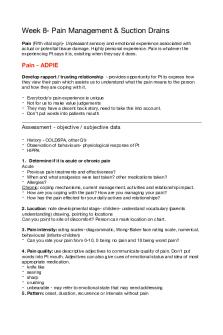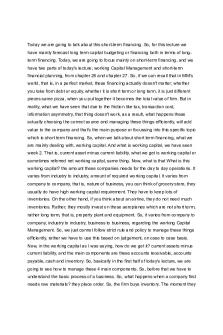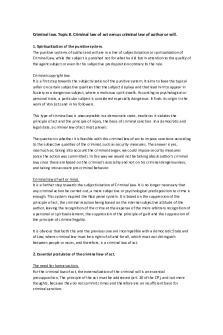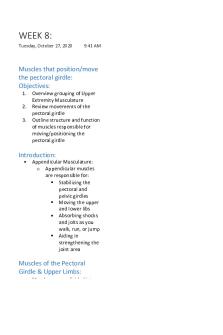Dating 2:7:19 - Lecture notes 8 PDF

| Title | Dating 2:7:19 - Lecture notes 8 |
|---|---|
| Course | Introduction To Archaeology |
| Institution | University of California Riverside |
| Pages | 3 |
| File Size | 60 KB |
| File Type | |
| Total Downloads | 88 |
| Total Views | 147 |
Summary
relative dating, absolute dating, radiometric dating...
Description
Ordering in Time Critical o Relative dating: established the relative (age) relationship between things o Absolute dating: assigns an age in year, expressing as a range in year (a +/symbol) 1. Calendrical (historical) dating Must be careful with the context 2. Dendrochronology and varve D: A dating method that links the growth rings in trees to calendrical time Tree-ring dating o Each year trees gain a growth ring o Uneven thickness of rings Narrower with the increasing age of the tree Annual climate changes affect tree growth o The bark (outermost) of a tree is the most important o Method: 1. Use drill to get a core 2. Count tree rings 3. Produce a diagram indicating the thickness of successive rings in an individual tree 4. Dating from present up to 10,000 B.P. (con) Pros: o Useful for calibration of radioactive dating Cons: o Not a universal method: applicable to trees outside the tropics Trees people used in the past Uneven thickness of rings o No precise date without the outermost rings o Cutting date does not equal the construction date Extended use Reuse Replacement of old timbers Use of old wood V: Cores (sea, lake, and ice) o Forms levels of sediments every year o Up to 52,800 B.P. o Limitations: Requires a specific environmental condition such as smooth ocean/lakes, surrounded by mountains, deep water depth, etc. in order to find data from remote times 3. Radiometric dating: dating methods that rely on calculations of a temporal length in which one half of a unstable isotope becomes a stable isotope Isotopes: elements that possess the same number of protons but vary in neutrons
Radioactive decay: transformation of unstable radioactive isotopes into stable isotopes Half-life concept: the time it takes for radioactive elements to decay Radiocarbon dating 14C First radiometric technique (1949) Developed by William Libby 1. Organic remains 2. Half decay of 14C is about 5730 years Accelerator Mass Spectrometry (AMS) o Directly counts 14C in the sample Limitations: o Calibration: production rate of 14C on earth not constant over time. It needs to calibrate with tree-ring dating. 14C dates must be calibrated to obtain calendar dates. The results always include estimate of possible error o Date up to 50,000 years B.P. o Poor choice of samples o What is dated is the sample, not necessarily the context o Contamination o Statistical uncertainty Potassium-Argon dating Decay of Potassium (40K) into Argon (40Ar) Use of volcanic rock sample (10g) From 100,000 B.P. (half-life is 1.3 billion) Refined method is 40Ar-39Ar dating Limitations: o Use volcanic ricks; indirect date o Useful only for areas buried by volcanic activity o Cannot date after 100,000 B.P. o Error range is 30,000 years (big) o Nevertheless, this is the most useful method for early humans (hominins) Uranium series dating A radiometric technique decay of uranium isotope (234U) into a thorium isotope (230Th) Dates calcium carbonates The range is 1000 – 500,000 B.P. Limitations: o Useful only in a limited environment such as caves with calcite layers or buried teeth o The correct order of deposition in a cabe is ambiguous o But, it fills the gap between 14C dating and 40K – 40Ar dating Fission track dating
4.
5.
6.
7.
The decay of 238U leaves pathways called fission tracks Use volcanic rocks and glasses Count the number of fissions an under optical microscope From 1 M to 2 B years ago Used for cross-checking Each absolute dating has limitations Direct and Indirect Dating o Matrix, association, context, etc. are important when figuring out indirect dating Reading the Past o Stratigraphy: the study and interpretation of the sequentially layered deposits of a site Terminus ante quem: limit before which Terminus post quem: limit after which o Stratification: the observed layering of matrices and features Architecture o Abutted walls: those are built up against existing construction o Bonded walls: those are built at the same time Construction Sequence Archaeoastronomy Seriation: idea that style changes over time o Ex. Sir Flinders Petrie in Egypt found different styles of pots o Ex. Battleship curves Ideal shape of a seriation curve o Ex. Northeastern headstones Climatostratigraphy Glottochronology: idea of language evolving as they spread farther away from the origin language...
Similar Free PDFs

Dating 2:7:19 - Lecture notes 8
- 3 Pages

8 - Lecture notes 8
- 21 Pages

8 - Lecture notes 8
- 21 Pages

8 Midwifery - Lecture notes 8
- 3 Pages

Taxation 8 - Lecture notes 8
- 2 Pages

Week 8 - Lecture notes 8
- 6 Pages

Dox 8 - Lecture notes 8
- 21 Pages

Lesson 8 - Lecture notes 8
- 2 Pages

Assignment 8 - Lecture notes 8
- 4 Pages

Week 8 - Lecture notes 8
- 23 Pages

WEEK 8 - Lecture notes 8
- 10 Pages

CL-8 - Lecture notes 8
- 12 Pages

Tema 8 - Lecture notes 8
- 8 Pages

Lesson 8 - Lecture notes 8
- 19 Pages

Chapter 8 - Lecture notes 8
- 7 Pages

Chapter 8 - Lecture notes 8
- 2 Pages
Popular Institutions
- Tinajero National High School - Annex
- Politeknik Caltex Riau
- Yokohama City University
- SGT University
- University of Al-Qadisiyah
- Divine Word College of Vigan
- Techniek College Rotterdam
- Universidade de Santiago
- Universiti Teknologi MARA Cawangan Johor Kampus Pasir Gudang
- Poltekkes Kemenkes Yogyakarta
- Baguio City National High School
- Colegio san marcos
- preparatoria uno
- Centro de Bachillerato Tecnológico Industrial y de Servicios No. 107
- Dalian Maritime University
- Quang Trung Secondary School
- Colegio Tecnológico en Informática
- Corporación Regional de Educación Superior
- Grupo CEDVA
- Dar Al Uloom University
- Centro de Estudios Preuniversitarios de la Universidad Nacional de Ingeniería
- 上智大学
- Aakash International School, Nuna Majara
- San Felipe Neri Catholic School
- Kang Chiao International School - New Taipei City
- Misamis Occidental National High School
- Institución Educativa Escuela Normal Juan Ladrilleros
- Kolehiyo ng Pantukan
- Batanes State College
- Instituto Continental
- Sekolah Menengah Kejuruan Kesehatan Kaltara (Tarakan)
- Colegio de La Inmaculada Concepcion - Cebu